User Interface - Leaderboard
A leaderboard using Element components. See the full scene.
This tutorial demonstrates how to create a simple leaderboard using the built-in Elements. The leaderboard is filled programmatically with data that come from a JSON asset.
Hierarchy
This is what our UI looks like in the hierarchy:

As you can see we have a 2D Screen, two Elements to show the title and sub title and two Image Elements which are going to be used as the backgrounds and panels for our leaderboard data. Under Your Score we are going to show the player's position in the leaderboard and under Leaderboard we will show the rest.
You will also notice a disabled Entity called Entry Template. This is a template that we will use for each row of the template. We will clone that template for each leaderboard entry that exists in our JSON asset and add each clone under the respective panel.
Screen setup
Our screen is set up like so:
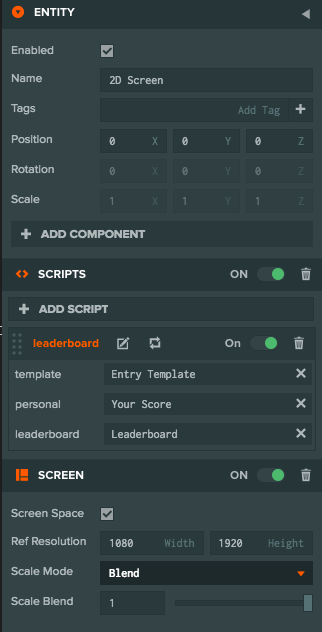
Since it's a 2D screen we have ticked Screen Space. Our Reference Resolution is the resolution that we are targeting - in this case it's 1080 x 1920. We choose Blend for Scale Mode so that our Screen adapts to resolution changes and we set Scale Blend to 1 so that the Screen will adapt only to height changes.
The screen entity also has a script component that contains the leaderboard script that we will see below.
Panel setup
For each panel we have an Image element that shows its background. Under the panel we are going to programmatically add clones of the Entry Template. Our panels are anchored to the center of the screen.
Entry Template setup
This is what our template for each leaderboard row looks like in the hierarchy:
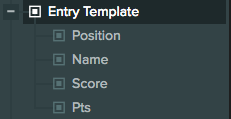
It has four child Text Elements for displaying the Position in the leaderboard, the name of the player, the player's score and a label that says 'PTS'.
The Entry Template itself is a Group Element:
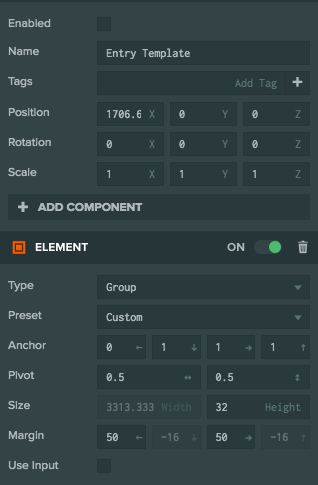
Notice how the Group Element has split horizontal anchors:
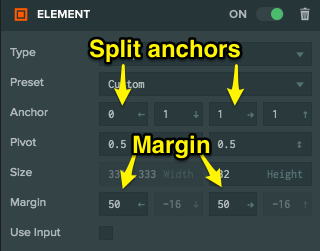
The horizontal anchors are not equal (they are 0 and 1) which means that the Element will expand automatically to fill the entire horizontal area if the Screen is resized. We also have a horizontal margin of 50 pixels to allow a small gap from the edges - the margin can only be set when anchors are split.
Now let's look at the rest of the Group's children.
Position
Position is anchored to the left:
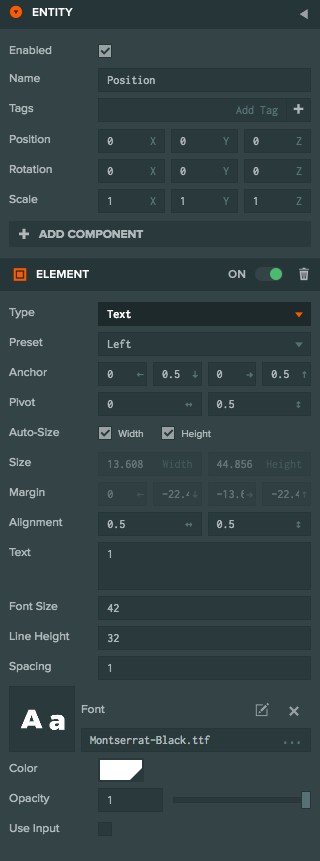
Name
Name is anchored to the left and moved a bit to the right:
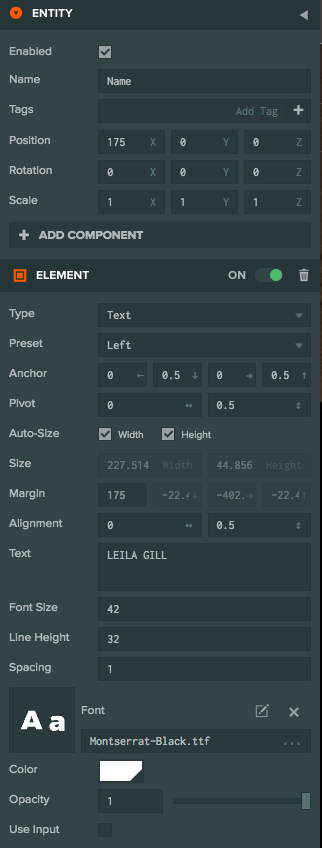
Score
Score is anchored to the right
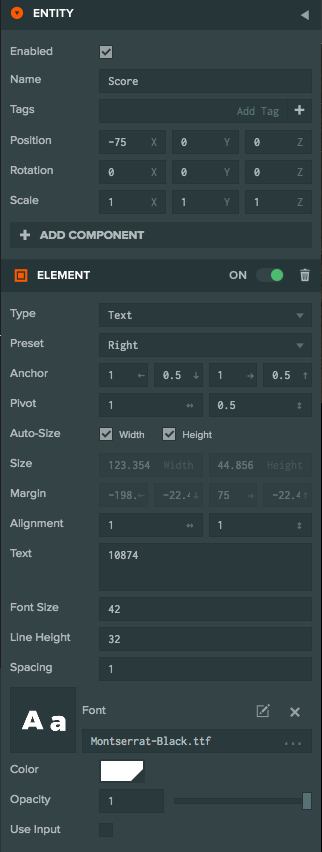
Points
Points are anchored to the right
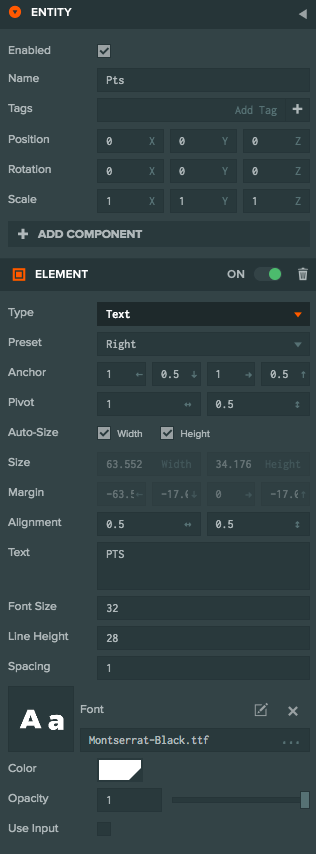
Script
This is the leaderboard script that reads our JSON asset and fills the leaderboard:
- ESM
- Classic
import { Script } from 'playcanvas';
export class Leaderboard extends Script {
static scriptName = "leaderBoard";
/**
* @attribute
* @title Template
* @type {Entity}
*/
template = null;
/**
* @attribute
* @title Personal
* @type {Entity}
*/
personal = null;
/**
* @attribute
* @title Leaderboard
* @type {Entity}
*/
leaderboard = null;
initialize() {
this.entries = [];
this.load((data) => {
this.clear();
// add the personal entry
let y = -75;
this.addEntry(this.personal, y, data.personal.position, data.personal.name, data.personal.score);
// add the top ten
y = -60;
for (let i = 0; i < Math.min(data.leaderboard.length, 10); i++) {
this.addEntry(this.leaderboard, y, i + 1, data.leaderboard[i].name, data.leaderboard[i].score);
y -= 99; // offset each entry
}
});
}
clear() {
this.entries.forEach(entry => entry.destroy());
this.entries = [];
}
addEntry(parent, y, position, name, score) {
const entry = this.template.clone();
entry.enabled = true;
entry.findByName("Position").element.text = position.toString();
entry.findByName("Name").element.text = name.toUpperCase();
entry.findByName("Score").element.text = score.toString();
this.entries.push(entry);
parent.addChild(entry);
entry.translateLocal(0, y, 0);
}
load(callback) {
const asset = this.app.assets.find("leaderboard-data.json");
asset.ready(() => {
callback(asset.resource);
});
this.app.assets.load(asset);
}
}
var Leaderboard = pc.createScript('leaderboard');
// the text entry template to clone
Leaderboard.attributes.add("template", {type: "entity"});
// the parent leaderboard for the personal score
Leaderboard.attributes.add("personal", {type: "entity"});
// the parent leaderboard for the top ten
Leaderboard.attributes.add("leaderboard", {type: "entity"});
Leaderboard.prototype.initialize = function() {
var self = this;
this.entries = [];
this.load(function (data) {
self.clear();
// add the personal entry
var y = -75;
self.addEntry(self.personal, y, data.personal.position, data.personal.name, data.personal.score);
// add the top ten
y = -60;
for (var i = 0; i < Math.min(data.leaderboard.length, 10); i++) {
self.addEntry(self.leaderboard, y, i+1, data.leaderboard[i].name, data.leaderboard[i].score);
y -= 99; // offset each entry
}
});
};
// clear all leaderboard entries
Leaderboard.prototype.clear = function () {
for (var i = 0; i < this.entries.length; i++) {
this.entries[i].destroy();
}
this.entries = [];
};
// add a new entry into the leaderboard
Leaderboard.prototype.addEntry = function (parent, y, position, name, score) {
var entry = this.template.clone();
entry.enabled = true;
entry.findByName("Position").element.text = position.toString();
entry.findByName("Name").element.text = name.toUpperCase();
entry.findByName("Score").element.text = score.toString();
this.entries.push(entry);
parent.addChild(entry);
entry.translateLocal(0, y, 0);
};
// Mock loading leaderboard data, for this demo we just get the data from a JSON file in the project
// For your project you could download this from a server backend
Leaderboard.prototype.load = function (callback) {
var asset = this.app.assets.find("leaderboard-data.json");
asset.ready(function () {
callback(asset.resource);
});
this.app.assets.load(asset);
};